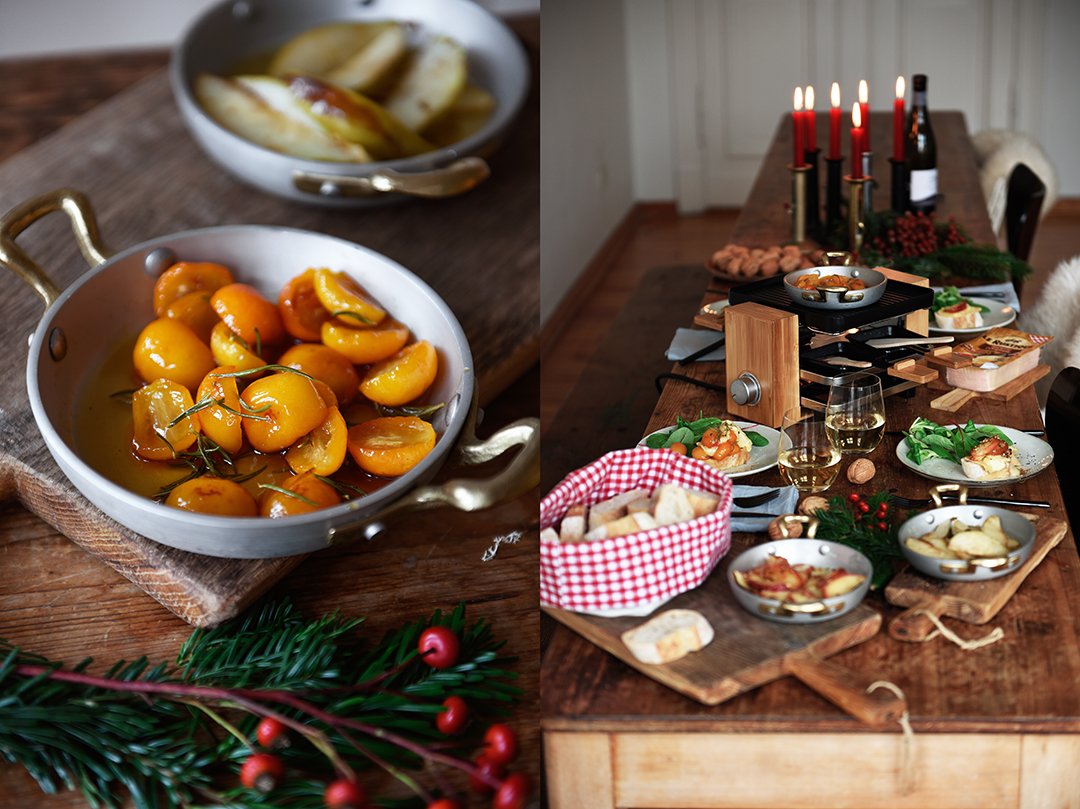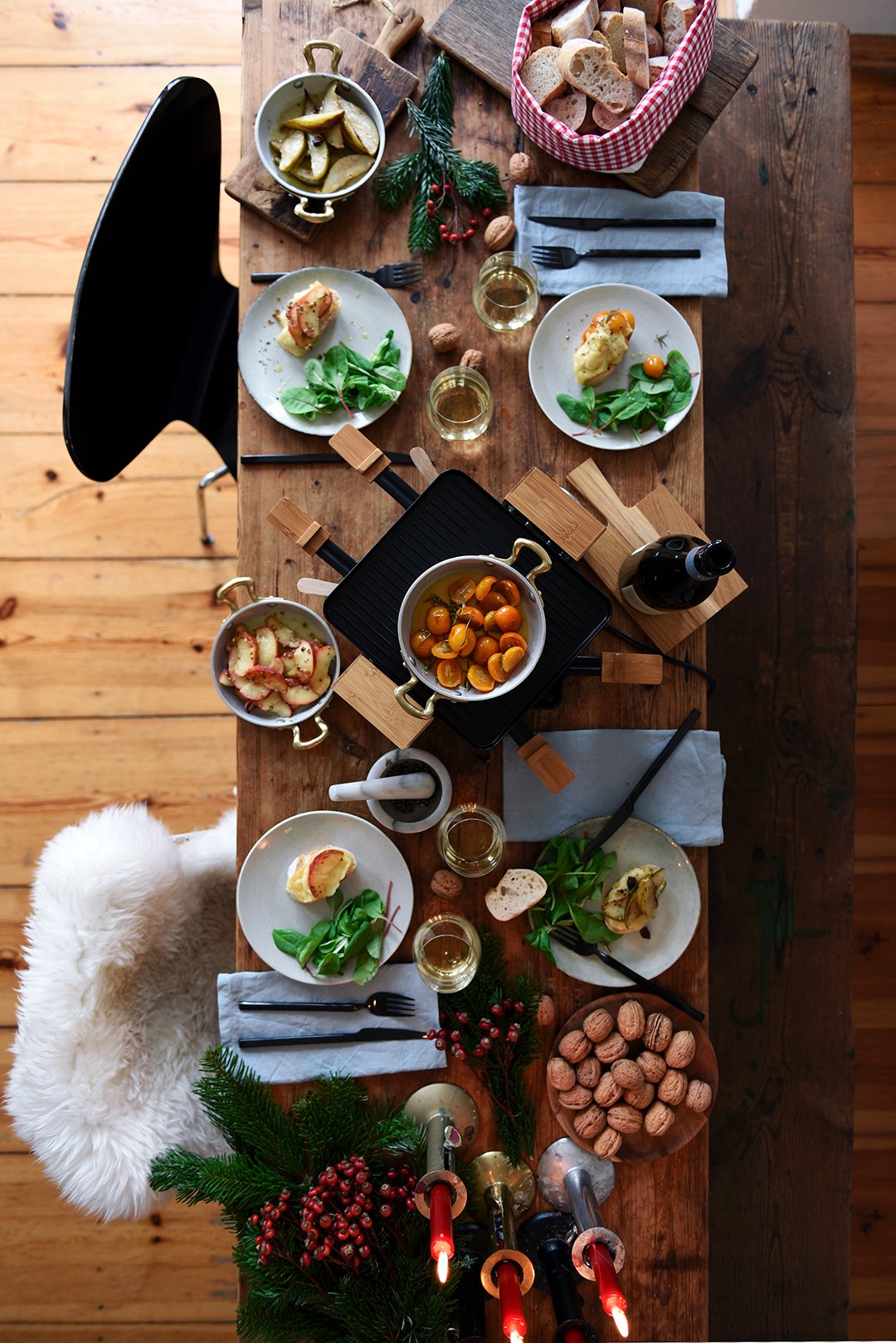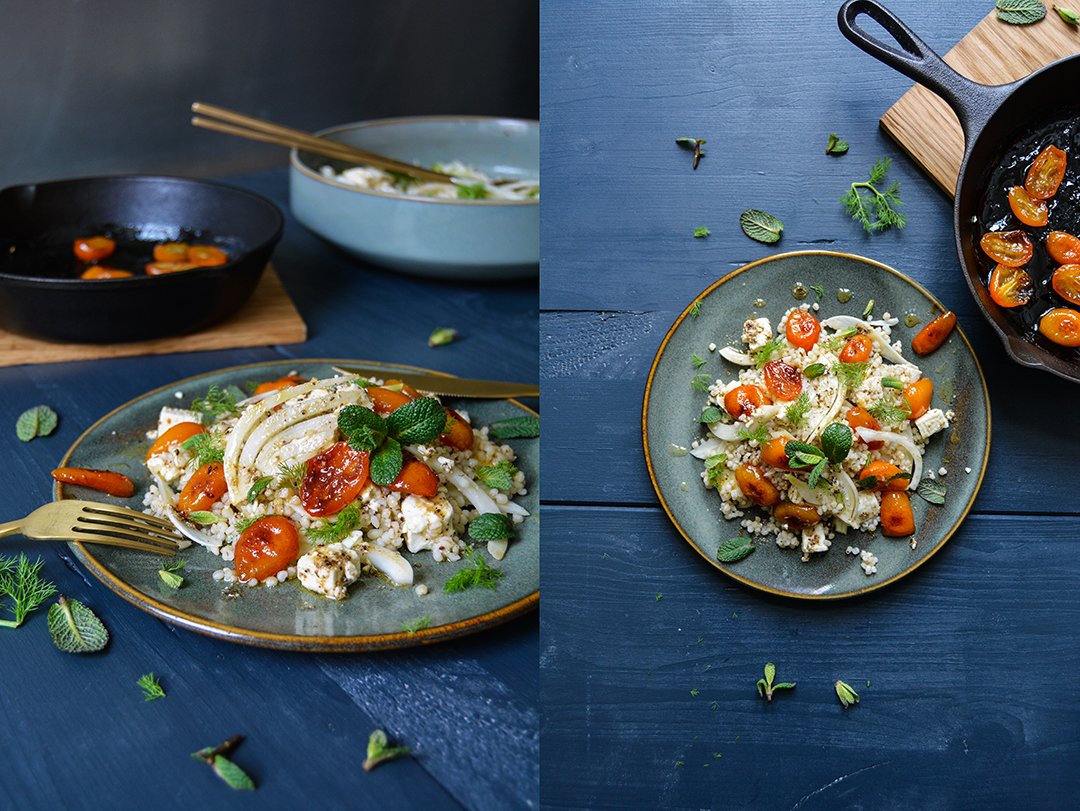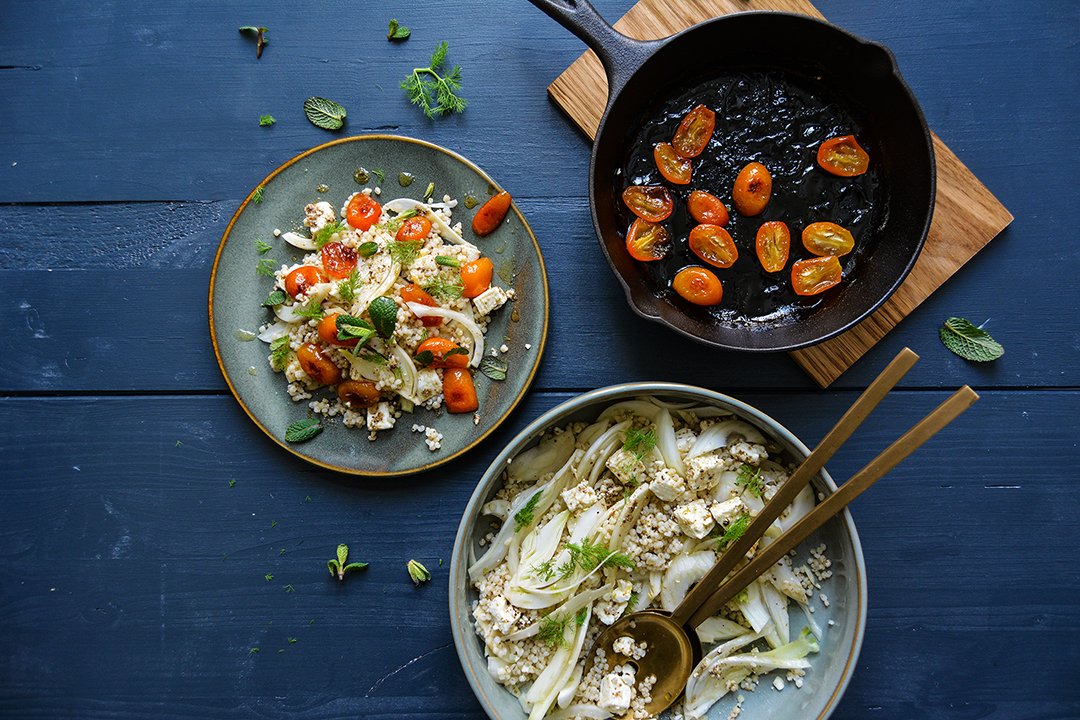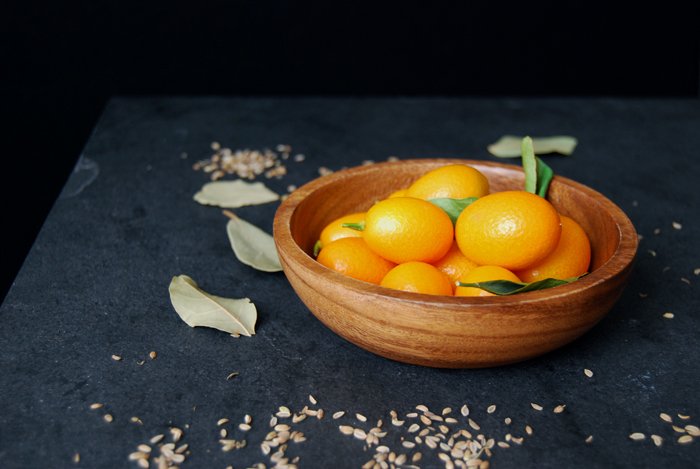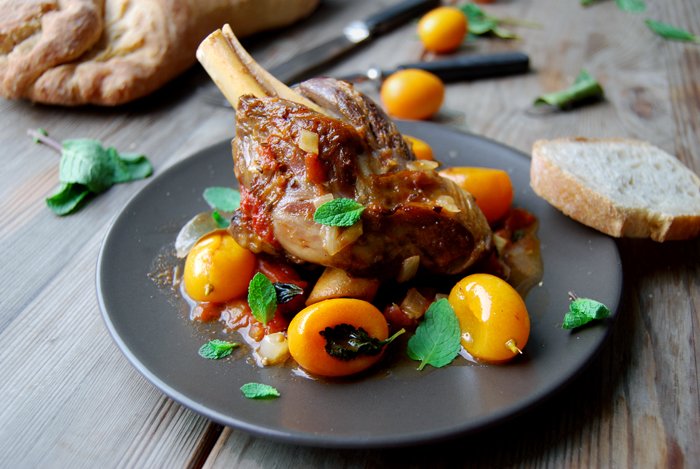Grilled Raclette with Rosemary Kumquats, Coriander Apple & Star Anise Pear
The light dimmed, tall candles casting flickering shadows on the ceiling, the room filled with the dry heat from the crackling fireplace and the smell of burnt wood and cheese lying in the air like a heavy cloud. When it's time for Raclette at my mother's house in the countryside, it's a celebration of everything that I connect with coziness. Surrounded by family and friends, everybody gathers around the sizzling Raclette grill to watch the magic happen: aromatic cheese melting and dripping, golden bubbles bursting and splashing as they touch the glowing grill, and the rind turning into smokey charred bites.
When you eat Raclette at a snow covered hut in the mountains, you would most likely enjoy it the classic way, with boiled potatoes, raw spring onions, pickled vegetables like gherkins (cornichons) and pearl onions, and lots of crushed or coarsely ground black peppercorns. The cheese needs added acidity, which can come from the pickles but it can also come from fruit.
So here's the fruity way to enjoy the fragrant melted cheese on a crusty baguette: I skip the pickles and go for Raclette with rosemary kumquats, coriander apple, and star anise pear. Kumquats cooked with honey and fresh rosemary turn the tiny citrus fruits into soft and caramelized bites. Pear wedges seared in star anise butter taste like Christmas and apple wedges softened in coriander butter are sweet, aromatic, and slightly sour. That's the colorful trio to complete my rustic Raclette table but you could also add roasted grapes or plums, or juicy persimmons. Whatever fruit you would normally eat with cheese will fit; it can only become better with a little heat, either in the pan on the hob or under the grill. The heat softens the fruit's texture and makes the flavor even more concentrated. I would keep the side dish simple, you can serve the grilled Raclette with a quick green salad.
My mother always uses a very old Swiss made grill that's rather large. It can hold half a wheel of Raclette, melting the surface where the cheese is cut in half, and then you scrape the melted layer right off the wheel onto your plate. It's a lot of fun, but it's heavy, you need a lot of people to eat up half a wheel of cheese, and you can only feed the hungry crowd in batches - around two people every time you scrape the top layer off, then the half-wheel needs to go under the grill again. This is not necessarily a bad thing seeing as we're talking about a meal that's rather rich and filling. A break once in a while doesn't harm the hungry cheese lover, but if I want to throw a cozy Raclette party just for two (or maybe a couple friends), I go for my more practical tabletop grill with single Raclette dishes instead. Then I opt for sliced cheese and grab Le Rustique's Raclette l'Originale. It's aromatic yet not overpowering and melts like butter. When I use sliced cheese I remove the rind, and if you're after that smokey burnt touch you can just leave the Raclette on a little longer until the charred bubbles burst under the grill.
Thanks to Le Rustique for sponsoring this post and reminding me of the coziest celebration of cheese: watching - and eating - bubbling and crackling Raclette.
Grilled Raclette with Rosemary Kumquats, Coriander Apple and Star Anise Pear
You'll need a Raclette grill for this recipe.
Serves 3 to 4
For the fruit
2 tablespoons honey
2 tablespoons fresh rosemary needles (whole needles, not chopped)
12 fresh organic kumquats (or canned kumquats, drained), cut in half lengthwise and seeds removed
4 tablespoons freshly squeezed orange juice
Unsalted butter, to cook the pear and apple
3 star anise
1 large, firm pear, cored and cut into thin wedges
2 teaspoons coriander seeds, crushed with a mortar and pestle
1 large baking apple, cored and cut into thin wedges
For serving
About 500-600g (18-21 ounces) sliced Raclette cheese (for a tabletop grill with single Raclette dishes), rind removed
1-2 crunchy baguettes, sliced
Crushed or coarsely ground black peppercorns
Optional
2 large handfuls mixed small leaf lettuce (young spinach and chard, mâche or corn lettuce)
Olive oil
Balsamic vinegar
Fine sea salt
Finely ground pepper
For the kumquats, in a small, heavy pan, heat the honey over high heat until bubbling. Add the rosemary, kumquats, and orange juice and cook, turning once, for 3-4 minutes or until golden brown and soft - mind that the kumquats don't burn. Set the pan aside and keep warm.
For the pear, in a medium, heavy pan, heat 2 tablespoons of butter and the star anise over medium-high heat until sizzling. Add the pear wedges and sauté, turning once, for about 3-4 minutes or until golden brown and tender. Set the pan aside and keep warm.
For the apple, in a medium, heavy pan, heat 2 tablespoons of butter and the coriander seeds over medium-high heat until sizzling. Add the apple wedges and sauté, turning once, for about 3-4 minutes or until golden brown and tender. Set the pan aside and keep warm.
Melt the cheese, one slice at a time, under the Raclette grill until bubbly then scrape onto a slice of baguette, top with kumquats, apple wedges, or pear wedges and season with crushed black pepper.
You can serve the grilled Raclette with a simple green salad on the side: Divide the mixed lettuce leaves among the plates, drizzle with a little olive oil and balsamic vinegar, and season to taste with salt and pepper.
Enjoy!
Feta and Fennel Barley with Caramelized Kumquats
My latest discovery of a barley recipe from Yotam Ottolenghi and Sami Tamimi's stunning Jerusalem cookbook was a life changing event in my kitchen. I finally like barley!
For years my mother has been trying to convince me of the little grain's qualities - unsuccessfully. I'm not a huge fan of orzotto or risotto, I can enjoy both of them for lunch but I wouldn't call them a great source of inspiration. But then, as I thumbed through the pages of Jerusalem, page number 81 caught my attention: Parsley & Barley Salad. The title doesn't mention the ingredient that changed everything for me, feta. The two London chefs marinate the cheese in spiced oil before they finish off their composition with barley, lots and lots of parsley, and spring onions. They also add cashews but I skipped them, I'm not too fond of nuts in my cooking.
So what happens is that, when I really like a recipe, my mind starts spinning looking for variations. First I added much more barley than mentioned in the recipe to turn it into a richer meal befitting these cold winter evenings. Then I stirred in raw, thinly sliced fennel, blood orange juice, mint, and honey-caramelized kumquats (an inspiration from last year's celeriac salad). Ottolenghi and Tamimi use za'tar for their spice oil, which I replaced with ground cardamom and fennel seeds. Crushed coriander seeds and allspice berries are taken from their recipe and add a warming touch to it.
You'll end up with quite a vibrant dish that can be eaten cold, as a salad, or slightly warm, as a main or side dish. Although the spiced oil, salty cheese, and sour kumquats are quite prominent, the nutty barley and crunchy fennel aren't shy here either. What's great about it, is that you can play with it, add and change spices, fruits, and vegetables according to your mood and the season. Just stick to barley and marinated feta, that's the secret.
Feta and Fennel Barley with Caramelized Kumquats
Serves 3-4
pearl barley 100g / 1/2 cup
olive oil 5 tablespoons, plus a splash
coriander seeds, ground in a mortar, 3/4 teaspoon
allspice berries, ground in a mortar, 1/2 teaspoon
fennel seeds, ground in a mortar, 1/2 teaspoon
ground cumin 1/2 teaspoon
ground cardamom 1/4 teaspoon
feta, cut into cubes, 150g / 5 ounces
medium fennel bulb, quartered, cored, and thinly sliced, 1
freshly squeezed blood orange juice 4 tablespoons
fine sea salt
ground pepper
fresh mint leaves, a small handful
For the caramelized kumquats
honey 2 tablespoons
kumquats, cut in half lengthwise, seeds removed, 12 (or 12 orange fillets, peeled)
freshly squeezed orange juice 4 tablespoons
Cook the barley in salted water until al dente, drain in a colander, and rinse briefly with water.
In a medium bowl, whisk the olive oil, coriander, allspice, fennel seeds, cumin, and cardamom. Add the feta and mix gently until the cheese is coated with oil and spices, set aside.
For the caramelized kumquats, in a small, heavy pan, heat the honey over high heat until liquid and bubbling. Add the kumquats and orange juice and cook for about 2 minutes or until golden brown on the bottom, turn and cook for another 1 1/2 - 2 minutes or until soft and caramelized; mind that they don’t become too dark.
Transfer the barley, sliced fennel, orange juice, and feta with the spiced oil to a large bowl and stir gently. Season with salt and pepper to taste, stir in a little more olive oil if it's too dry. Sprinkle with mint and arrange the kumquats on top. Enjoy warm or cold.
Braised Lamb Shanks with Kumquat, Fennel, Cardamom and Mint
This is the most tender, aromatic and colourful braised dish you can possibly have on your plate at this time of year, at least in the Northern hemisphere. Cardamom, cumin, fennel and coriander seeds refine the deep red juices of summery (tinned) tomatoes cooked with succulent lamb shanks before tiny yellow kumquats add their bittersweet fruitiness. The fresh mint leaves on top are more than just pretty in this warming composition, their job is to freshen it up! A sheer explosions of aromas!
Over the years, I have become a big fan of shanks in my kitchen whenever I'm in the mood for a stew. Be it beef, veal or lamb, I prefer this cut over chuck steaks. The meat around the bone is packed in fat which keeps it juicy and tender while it braises in a fragrant broth of wine, fruit and vegetables. Shanks usually taste quite strong, they can easily deal with spices and herbs, perfect for Mediterranean comfort cooking with lots of rosemary, thyme, sage and garlic, or to find some inspiration in the Arabic cuisine. All those spices, those warming corns, pods and powders, cumin, turmeric, cayenne, cinnamon and many more, this is the best moment to let their qualities shine. Spices are great on their own but even better in a team. Be experimental, combine your favourites and use a little bit more than you usually would, the meat and sauce can take it!
Braised Lamb Shanks with Kumquat, Fennel, Cardamom and Mint
You need an oven proof dish / casserole dish with a lid for this recipe.
For 3-4 people you need
lamb shanks 3-4
fennel seeds, crushed in a mortar, 2 teaspoons
coriander seeds, crushed in a mortar, 1 teaspoon
ground cardamom 1 teaspoon
ground cumin 1 teaspoon
medium onion, finely chopped, 1
garlic, cut in half, 4 cloves
white wine 400ml / 1 pint
tinned tomatoes of good quality (it's worth going for a good brand!) 400g / 14 ounces
bay leaves 2
orange peel 4 long strips
kumquats, rinsed, 8
sea salt and pepper
olive oil
fresh mint leaves, a small handful
Set the oven to 160°C / 320°F.
In a casserole dish, heat a splash of olive oil and sear the shanks for a few minutes until golden brown on all sides. Take the meat out and set it aside but keep the casserole dish on the heat. Add a little more olive oil and the fennel seeds, coriander, cardamom and cumin, cook for about 20 seconds on medium heat or until you smell the spices, stir constantly. Add the onions and garlic and cook for 1-2 minutes. Mix the lamb shanks with the spices and onion and pour the wine over the meat. Season with salt and pepper. Add the orange peel, bay leaves and tomatoes, chop them roughly, mix everything and bring to a simmer. Close the casserole dish with a lid and cook in the oven for 1 1/2 hours. Add the kumquats (whole, not cut) and cook for another 30 minutes or until the meat is tender and you can lift it with a fork off the bone.
If necessary, take out the meat when it's done and cook down the sauce. Season to taste and serve with fresh mint leaves and thick slices of white bread or flatbread.


